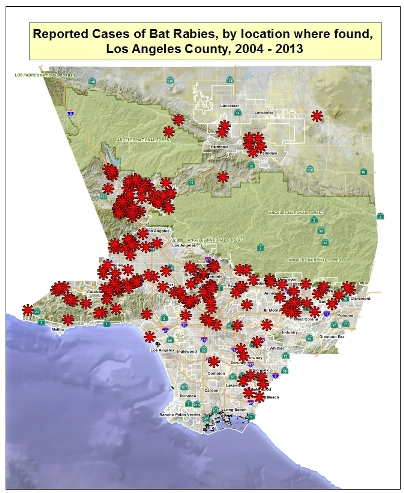Domestic Animals
Rabies is very rare now in pets in Los Angeles
County. The risk of rabies is low because of
laws requiring rabies vaccination of pets, and
because of control of stray animal populations
by Animal Control services.
Years of key rabies cases in domestic animals
in Los Angeles County:
2004 - Imported Dog. A stray 10
week old
puppy in Thailand was rescued by a California
resident. The puppy was ill before the flight to Los
Angeles. After arrival at the Los Angeles
International Airport (LAX), the puppy was taken
to see local veterinarians. The puppy's owners
drove north and stopped at two more veterinary
clinics along the way. The puppy became
increasingly aggressive. It was finally
euthanized at a veterinary clinic in
Santa Barbara, where it was diagnosed with
rabies. An international investigation
identified 12 people that may have had direct
contact with the puppy's saliva while it was
rabid.
1987 - Imported Cat. A stray kitten
in Acapulco, Mexico was rescued
by California resident. The kitten was attacked by a dog in Mexico
and survived. While still in Mexico, it started to show
symptoms of aggression. The kitten
was flown from Mexico to Los Angeles. It died at a veterinary practice 4 days
after it was imported, and rabies was confirmed.
Three people in the US had been bitten by the
rabid kitten. An additional 20 people (11 in the
US, 9 in Mexico) had possible exposure to its
saliva. All 23 were referred for
rabies post-exposure prophylaxis.
1970s-Local Dogs. Four cases of rabies in dogs were
identified throughout the 1970s. They were believed to have been caused by a
live-virus vaccine in use at the time. When
veterinarians began using only killed virus
vaccines, dog rabies cases stopped being
identified. .
1966 - Local Dog. Last
naturally-occurring rabies case in a local dog.
The dog was suspected of having caught rabies
from a skunk.
Wild Animals
Since 1979, only 'bat variants' of rabies in Los
Angeles County. Bat rabies
variants are strains of the rabies virus that
spread most easily between bats. However, they
can also still be spread to other animals by
bites. We used to have skunk rabies variants
here (strains that spread most easily between
skunks). There are other rabies variants in
North America such as raccoon, fox and
dog-coyote variants. These variants could
eventually be transported here through
relocation of animals. Therefore all bites from these
wild animals are of potential rabies concern.
Years of key rabies cases in wild animals
in Los Angeles County:
2019 - Bats. Rabies has been
documented in bats every year in our county
since we started testing sick bats in 1961.
Bats continue to be our most important
reservoir for rabies. Bats are the most
commonly diagnosed rabid animals in the state of
California. However, most bats in nature do not
have rabies (<1%). Each red star
in the map at right documents the location of a
rabid bat found in our county over a 10 year
period, between 2004-2013. Rabid bats have been
found in both rural and urban areas in our
county. Click
here for our latest rabid bat map.
2014 - Skunk.
In 2014, a skunk in Long Beach was confirmed to
have rabies. The skunk was found to be
infected with the Mexican Free-tailed Bat
variant of rabies, not the skunk variant. As a
result, the local epidemiology regarding rabies
remained unchanged - bats are still the primary
reservoir locally. However this case served as a
stark reminder that wild animals can become
infected with rabies from bats.
Before 2014, the most recent
rabid skunk was found in the Malibu area in
1979. Throughout the 1950s and 1960s, rabid
skunks were repeatedly found near or in Malibu.
The outbreak peaked in 1964, when 59 rabid
skunks were found near Malibu area in one year. A wildfire in the Santa
Monica Mountains in 1979 may have killed the
last rabies-infected skunk population.
Skunks continue to be the second-most commonly
diagnosed rabid animal species in California.
1973- Raccoon. One rabid
raccoon was identified that year. Most likely it
had become infected by a local rabid skunk.
Although rabies is rare in local raccoons, the
"raccoon variant" of rabies may be brought over
from the East Coast of the US.
1964 - Foxes. Four rabid foxes
were documented in our county that year. They
were likely infected by rabid skunks. No other
rabid foxes have been identified since then.
However, foxes are the third-most-commonly rabid
animal species in the state of California.
1946 - Coyote.
Rabies has been rare in coyotes in our county.
The most recent case detected was in 1946 - it
was likely infected by a rabid dog at the time.
Rabies is found on coyotes sporadically
along the Texas-Mexico border.
1944 - Opossum. One rabid
opossum was detected in our county that year.
Rabies is rare in opossums, however 11 rabid
opossums were detected in California over
a 30-year period (1983-2012). One rabid opossum
was found in nearby Orange County.
Last updated: August 5, 2019